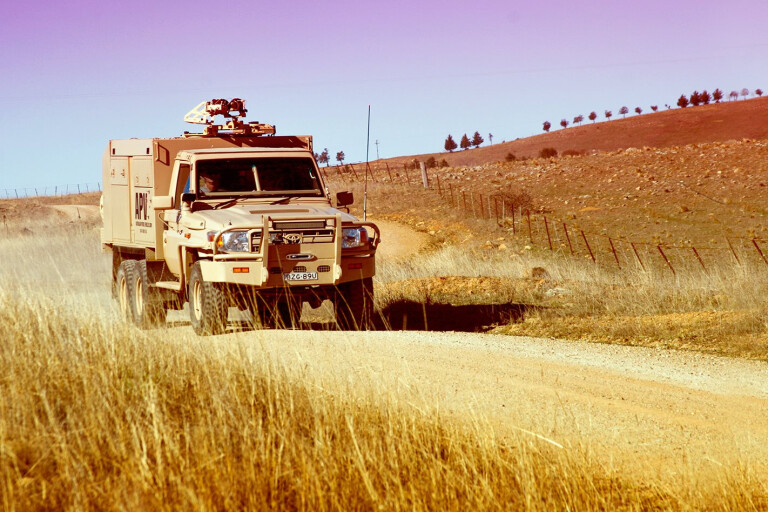
Michael McMillan is a man with wide-ranging ideas. Not only has he built a vehicle that can travel unsupported over all sorts of terrain, he aims to sell it worldwide. To this end he has founded a Townsville-based company called Australian Patrol Vehicles (APV).
The vehicle in question is what’s known as a Long Range Patrol Vehicle, or LRPV. It’s the sort of vehicle Australian SAS Special Forces troops used to good effect in recent conflicts in Afghanistan and Iraq.
But there’s a key difference here: where those SAS vehicles were Land Rover-based, Michael has decided to base his on a 79 Series Toyota LandCruiser.
Michael comes at this from a position of considerable experience. He’s been an Australian Army engineer for 20 years, reaching the rank of major. Before that he had 15 years infantry experience. Michael’s engineering experience extends to being heavily involved in the army’s recent adoption of Mercedes-Benz G-Wagens in place of its long-serving Land Rover Perentie Project that originated in the early 1980s. In what the army calls Land 121 Phase 3A (effectively the G-Wagen program) Michael was a senior systems engineer who worked directly with Mercedes- Benz engineers to help adapt the G-Wagen to Australian Army requirements and standards.
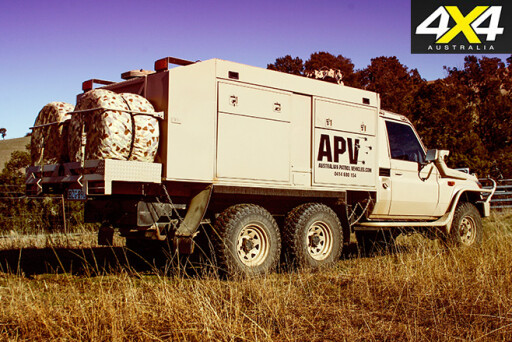 In designing his LRPV, Michael has been assisted by a serving Australian Special Forces warrant officer with 37 years of special forces experience, including a considerable amount of time spent in the Australian SAS, widely regarded to be as good, if not better, than any special forces on the planet. His name is David.
In designing his LRPV, Michael has been assisted by a serving Australian Special Forces warrant officer with 37 years of special forces experience, including a considerable amount of time spent in the Australian SAS, widely regarded to be as good, if not better, than any special forces on the planet. His name is David.
David’s hands-on SAS experience with the army’s LRPV was instrumental in designing the rear compartment – the eating, living, service, stowage and fighting part of APV’s vehicle.
APV’s LRPV took more than two years to develop using two 79 single-cabs as prototypes – a 2011 and a 2012. That was followed by extensive testing including month-long desert tests. A key part of the design is that it has to be fully self-supporting in terms of fuel, food and water for three men for up to 21 days and/or 2500km at a time.
WALK AROUND
The thing that first strikes you about the APV is how big it is – it dwarfs a stock 79 Series (or a 76 or 78 for that matter) largely due to its length. The most forward of the two rear axles is 300mm rearward of the stock’s 79 rear axle, and then you have second axle behind that. The overall length (including the four rear-mounted spare tyres) is some 6.7 metres.
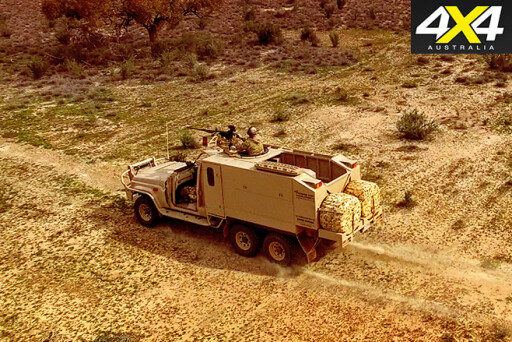 The rear axles use a walking beam arrangement and are currently on leaf springs, but a coil-sprung arrangement with Ikon dampers is under development in conjunction with Jmacx Off Road Solutions. The vehicle we drove was fitted with limited-slip diffs, but lockers are an option. Up front the LRPV runs heavy-duty coils and Nitro dampers, while 285/75 R16 LTs are fitted all ’round.
The rear axles use a walking beam arrangement and are currently on leaf springs, but a coil-sprung arrangement with Ikon dampers is under development in conjunction with Jmacx Off Road Solutions. The vehicle we drove was fitted with limited-slip diffs, but lockers are an option. Up front the LRPV runs heavy-duty coils and Nitro dampers, while 285/75 R16 LTs are fitted all ’round.
The chassis extension is augmented and further strengthened by a second chassis that carries the specially designed body components. This comprises the gunner’s compartment and the separate cargo module, which has a kitchen and various stowage areas.
Down the left side, behind the access door to the gunner’s compartment, is stowage for ammunition, weapons, spares, tools and the like. Behind that in a separate compartment is stowage for three regular jerrycans and three half jerries for fuel and oil. Mounted across the rear of the vehicle are four spare tyres.
The fuel- and oil-carrying arrangement on the left-hand side is mirrored at the rear of the right-hand side of the vehicle. Forward of that on the right-hand side is the kitchen comprising slide-out fridge, fold-down bench, pantry and 100- litre water tank. Forward of the kitchen is partitioned stowage for three full backpacks and three day packs for the three-man crew, with additional stowage for the camouflage nets. This ‘living’ side of the vehicle also has a fold-out awning.
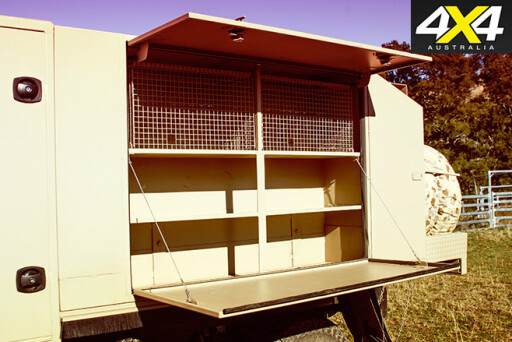 Inside the gunner’s compartment is a side-facing seat with a cut-out, so that the gunner can communicate easily with the driver and vehicle commander up front. Immediately behind the gunner’s seat is the stand-up firing position with its roofmounted 360-degree weapons ring.
Inside the gunner’s compartment is a side-facing seat with a cut-out, so that the gunner can communicate easily with the driver and vehicle commander up front. Immediately behind the gunner’s seat is the stand-up firing position with its roofmounted 360-degree weapons ring.
The 360-degree mount can be used for a variety of weapons, most commonly a heavy (.50 calibre) machine gun but also a mini-gun (an automated multi-barrel modern Gatling gun) or an automatic 40mm grenade launcher. There’s also additional stowage space in the gunner’s compartment.
Behind the gunner’s compartment you can walk through to the central stowage area, which among other things has three fold-jump seats for transporting extra personnel in an emergency. This area can also be used to carry extra jerrycans for fuel and water, plus it has a removable canvas top.
While the rear of the LRPV is a work of wonder, the front is even more unusual. Given, as Michael said, “you can’t fire out of the windscreen”, the front of the vehicle can be stripped down when in patrol mode.
 In a system Michael calls “soldier proof”, the roof, windscreen, windows and doors can be easily removed. First the canvas roof comes off then the roof channels that connect the A and B pillars clip out. Once that’s done the windscreen can be lifted out. All this can be done in a matter of minutes by one person if need be. Separately, the side windows can be removed from the doors (or the doors removed altogether) to make it easier to get out of the vehicle quickly in an emergency. The fact that the roof, windscreen and doors can be quickly refitted also means comfortable weather protection for the crew when not in patrol mode.
In a system Michael calls “soldier proof”, the roof, windscreen, windows and doors can be easily removed. First the canvas roof comes off then the roof channels that connect the A and B pillars clip out. Once that’s done the windscreen can be lifted out. All this can be done in a matter of minutes by one person if need be. Separately, the side windows can be removed from the doors (or the doors removed altogether) to make it easier to get out of the vehicle quickly in an emergency. The fact that the roof, windscreen and doors can be quickly refitted also means comfortable weather protection for the crew when not in patrol mode.
To strengthen the cab, mine-specification rollbars are fitted front and rear, which are further braced by a ‘wire cutter’ that runs from the front rollbar to the rear rollbar. As Michael said: “You don’t want to decapitate yourself when you are forced to drive through a fence at speed.” On that subject, the bullbar made by Townsville’s O’Connor Body Fabrications is designed to withstand hitting a 10cm tree at 30km/h. The bar mounts a 5500kg Runva winch and recovery and airportability points so the vehicle can be carried under a heavylift helicopter.
For the vehicle commander, who sits beside the driver, there’s a weapon mount on the rollbar that typically carries a medium-calibre machine gun.
 BEHIND THE WHEEL
BEHIND THE WHEEL
There were no weapons fitted when we drove the LRPV, but it nevertheless has an imposing and intimidating presence driving along the road.
It feels heavy and, given its kerb weight of 4700kg, that’s not surprising. Still, the 4.5-litre V8 has no trouble moving the LRPV.
Since we drove the LRPV Michael has fitted a three-inch exhaust to further improve the engine’s performance. It’s well known that this engine has plenty of potential, as the standard state of tune is very soft in the typically conservative Toyota way.
The standard gearing with the five-speed manual, which always feels way too short in a stock 79, feels tailor-made for the LRPV given all the extra weight. If required the LRPV can be fitted with an automatic gearbox, such as the six-speed from the LC200.

END GAME
Michael has based his LRPV on the 79, as it’s a well-proven, durable platform that’s supported right around the world with service and commercially available off-the-shelf parts. Being a Toyota the LRPV also has what’s called in military terms a low signature, which means it doesn’t readily stand out – a vital part of covert patrolling.
Potential customers for APV’s LRPV start with the US military but extend to European, North African, South American and Middle East militaries. It really extends to any government, non-government or paramilitary/security organisation that needs a self-supporting long-range vehicle with or without weapons or strip-down capability. The modular design also means multiple configurations can be achieved off the one platform, so vehicles can be tailor-made to individual customer requirements (called mission configurable).
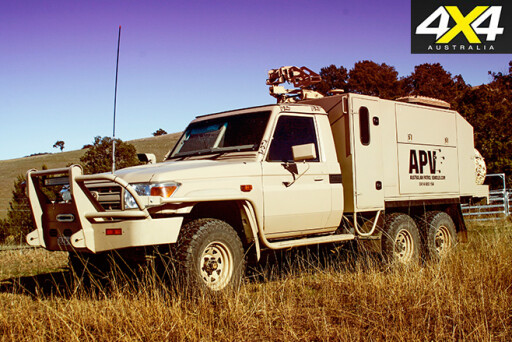 SPECS:
SPECS:
Max power: 153kW (see text)
Gearbox: 5-man/6-auto
Drive system: part-time 6x6
Wheels: 16-inch steel
Tyres: 285/75R16 LT (+ four spares)
Kerb weight: 4700kg GVM: 6800kg
Tow capacity: 3500kg
Seating: 3 permanent/6 emergency
Fording depth: One metre
Fuel capacity: 180-litre
Extra fuel: Up to 220 litres in jerry cans
Water storage: 100-litre tank
Extra water: Up to 200 litres in jerry cans
Check out the video of the APV LRPV test driving in the Simpson Desert.
For more information on APV visit australianpatrolvehicles.com

COMMENTS